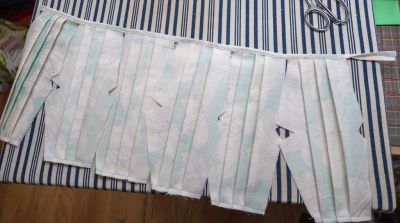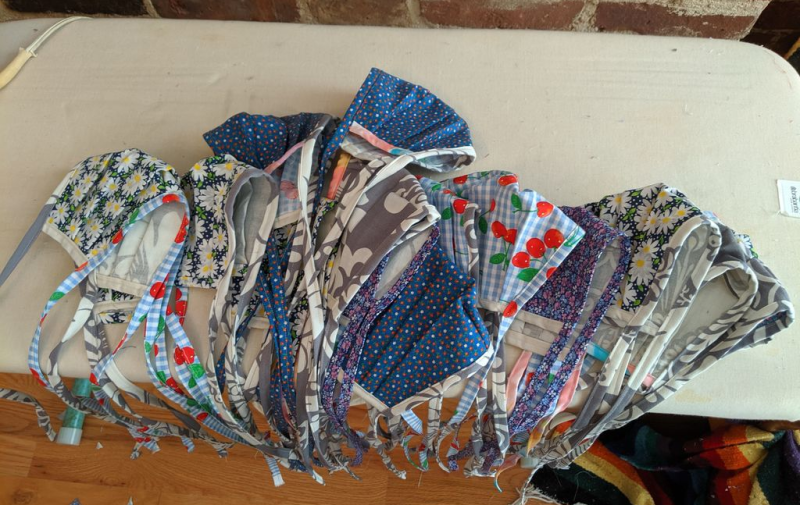Just as 3D printers around the world have been churning out face shields, the thread injectors of home sewists have been stitching up fabric masks. Over the past several weeks, [Becky Stern] has made them for friends, family, neighbors, and anyone in her community who happens upon the box of free masks she’s left at a nearby bus stop. This is in addition the scores she has made and donated to health care workers so they can extend the life of their N95 masks.
 If you’re going to make more than a few of anything, it just makes sense to make multiples at the same time and adjust the process for batch production. [Becky Stern] has some great ideas for ramping up assembly even further that include cutting out multiple main mask pieces at the same time, and ironing the pleats of several masks round robin style so you don’t waste time while they cool.
If you’re going to make more than a few of anything, it just makes sense to make multiples at the same time and adjust the process for batch production. [Becky Stern] has some great ideas for ramping up assembly even further that include cutting out multiple main mask pieces at the same time, and ironing the pleats of several masks round robin style so you don’t waste time while they cool.
Even if you don’t dabble in the fabric arts, her method of kitting out the process of mask making is an interesting look into small-scale production.
Our favorite idea concerns the side bindings and the straps, which are the last part of the build and take the longest to do. [Becky] makes several miles of straps ahead of time with a 3D printed bias tape folder and then sews them all into a continuous strip. She can add the short side bindings to a bunch of masks at once, feeding them in one after the other so they end up strung together like sausages. Then she can just snip them apart and keep going, having saved both time and thread. Watch [Becky] make a single mask after the break and see how easy it is.
If sewing is a no-go for you, there are plenty of ways to help the PPE effort by firing up that printer.
















Thanks for the post! If you want to send masks to NYC or donate $, my recommendations is NYCMakesPPE.com (production and distribution effort organized by hackerspaces and others in NYC)
Hi Becky, terrific video! Thank you for making it, and thank you for donating masks to the community!
I apologize in advance as I assume you get unsolicited suggestions often, but I’d like to offer a suggestion to improve filtration efficiency, which could be important for community masks that are not worn over actual surgical masks. Consider adding a middle layer of non-woven polyester between the cotton layers. The cotton layers act as mechanical filters, keeping out water droplets and sprays, but they’re not a perfect trap for smaller particles. Polyester has a strong static charge that attracts and traps sub-micron sized particles like viruses. Think static cling, but in a useful way.
At our house we have a wide variety of stabilizing fabrics we use for machine embroidery. After examining them all I found the Insipira Whisper Web to be the most similar to the filter layer inside a commercially made surgical mask. As a bonus, it’s a very breathable fabric so it stays comfortable to wear. But just about any of the non-woven polyester stabilizers would do a good job of attracting particles. I’m sure that bolts of non-woven polyester can be had for a lot cheaper than a roll of pre-packaged specialty stabilizer, but I haven’t shopped around for them. The key is to find a tight fabric that doesn’t have mechanical holes, and that is breathable.
Whatever you choose, to ensure it holds a charge the polyester fabric must be completely clean. Don’t re-purpose a used fabric softener sheet. Don’t use coated materials, like iron-on interfacing. And I’m not sure about the effectiveness of dyed or painted polyester, so I wouldn’t recommend them.
It’s also important to note that for any mask to remain effective, they must never be washed with fabric softeners, detergents containing fabric softeners, dried with dryer sheets, or treated with any product that reduces static cling. You don’t want to use anything that might plug up the filters or reduces the static charge of the polyester. Plain laundry detergent and a plain water rinse is best.
Thanks again!
John
I whipped up a few masks (not nearly as nice as this) using stuff from the dollar store, but I can’t sew for crap so I just used some iron stitch stuff and it turned out pretty well, so if you can sew maybe adapt Becky’s approach with the iron stitch (also good if you don’t have a sewing machine, I ain’t hand stitching a mask!) Here’s a link to the iron stitch stuff…
https://www.amazon.com/Dritz-Witchery-Fusible-Bonding-Weight-625/dp/B0001DSIHI
If you can’t sew try this stuff.
https://www.youtube.com/watch?v=YGNwg3cpEoo
So we’re trusting the box of free masks left at a bus stop now? Seems like a step backwards.
Most of the masks my wife makes leave the house with out being washed, because most the people asking her for them plan to wash them themselves.
They get sealed in a bag, and are likely only unsealed right before they hit soapy warm water.
I pack an info slip in with my packaged masks to tell folks about what they are made from, to wash before using, and that they have been washed and stored in plastic for a minimum of 72 hours before distribution. Agree that the supply chain collapse is a step backwards, helping your community is not.